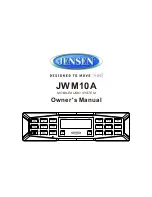
MiVoice Office 250 Installation and Administration Guide
398
Extension Numbers
Each node has an extension and feature code programming. However, the network should have a
universal numbering plan so that extension numbers on the various nodes do not overlap and do
not conflict with feature codes. That is, when planning the extension numbers for each of the nodes
in the network, set aside a block of extension numbers (for phones, hunt groups, Voice Processing
applications, etc.) for each node.
Programming Off-Node Extension Numbers
You can give users access to phone, hunt group, Voice Processing application, and page port
extensions on other nodes in two ways:
• You can manually program off-node devices (extensions from other nodes) into the database
of the node you are programming. To give a node access to an off-node device, program the
extension number, username, description, device type (phone, hunt group, Voice Processing
application, or page port), and node identification number. The network uses the username and
descriptions for directory features only. If you define an extension conflict, DB Programming
does not allow you to exit the screen until you correct the conflict.
• You can import and export new extensions as you create them. When you add a new extension,
DB Programming automatically makes the new extension visible to the other nodes in the net
-
work. Or you can manually export local devices to other nodes (or import devices from other
nodes) using the Export/Import option in DB Programming. The network broadcasts the new
extension number (along with the username, description, device type, and node identification
number) to the other nodes in the network and places it in their off-node device lists. If there is
an extension conflict on another node, the node with the conflict ignores the new extension in
favor of the previous extension number. Also note that if the network is unable to route the
broadcast message to a node, that node will not be able to receive and re-broadcast the new
information and it must be entered manually. (If Message Print is enabled, error messages will
indicate any unsuccessful broadcasts.)
Each node can have only 10,000 off-node device entries in its database. Once that limit has been
reached, new devices received through network broadcasts cannot be added to the node’s database.
You can make room in the database for new extensions by setting up wildcard extensions as
described below.
If you change a device extension, username, or description, the network automatically broadcasts
that extension change to the entire network and updates any existing off-node devices on the other
nodes. If the network is unable to export or import an extension because there is an active
programming session on that node, the node is unable to communicate with its Voice Processing
port, the node is down, or the links to the node are down, the new extension will not be added to or
changed on that node. You must manually add or change the new extension in the node database.
You may want to check each node to verify that their off-node device lists are programmed properly
to allow access between the nodes.
Nodes are assigned extension numbers that users can dial to reach phones which are not
programmed as off-node devices on their node. Also, if the same extension number exists on two
nodes, the only way a user can call the extension on the other node is to dial a node number before
dialing the extension number. For example, if extension 1200 exists on both Node 1 and Node 2,
users on Node 1 must first dial the node number for Node 2 to before dialing extension 1200 on
Summary of Contents for MIVOICE OFFICE 250
Page 1: ...MiVoice Office 250 INSTALLATION AND ADMINISTRATION GUIDE RELEASE 6 3 SP3 ...
Page 24: ...MiVoice Office 250 Installation and Administration Guide xxiv ...
Page 29: ...Chapter 1 MiVoice Office 250 New Features ...
Page 54: ...MiVoice Office 250 Installation and Administration Guide 26 ...
Page 55: ...Chapter 2 Document Overview ...
Page 62: ...MiVoice Office 250 Installation and Administration Guide 34 ...
Page 63: ...Chapter 3 Product Description ...
Page 86: ...MiVoice Office 250 Installation and Administration Guide 58 ...
Page 87: ...Chapter 4 Specifications ...
Page 157: ...Chapter 5 Installation ...
Page 251: ...Installation 223 ...
Page 274: ...MiVoice Office 250 Installation and Administration Guide 246 4 Test for quality ...
Page 396: ...MiVoice Office 250 Installation and Administration Guide 368 ...
Page 397: ...Chapter 6 Reference ...
Page 416: ...MiVoice Office 250 Installation and Administration Guide 388 ...
Page 417: ...Appendix A Private Networking ...
Page 445: ...Appendix B Network IP Topology ...
Page 486: ...MiVoice Office 250 Installation and Administration Guide 458 ...
Page 487: ...Appendix C Open Source License Agreements ...
Page 506: ...MiVoice Office 250 Installation and Administration Guide 478 ...
Page 507: ...Appendix D Phones ...
















































